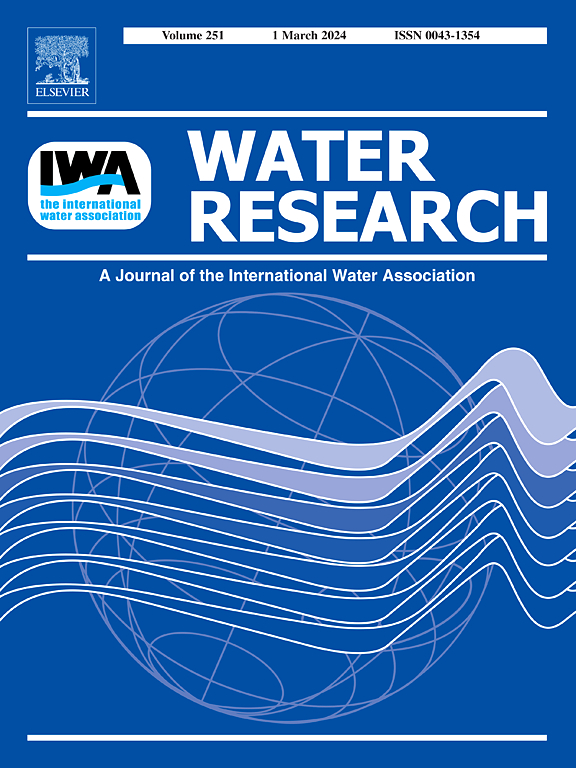正能量污水处理的侧流厌氧膜生物反应器系统
IF 12.4
1区 环境科学与生态学
Q1 ENGINEERING, ENVIRONMENTAL
引用次数: 0
摘要
厌氧膜生物反应器(AnMBRs)是发展能源中性废水处理系统的一个有前途的解决方案。然而,在直接处理污水的主流环境中,它们的应用面临着溶解甲烷损失和低温下性能下降等挑战。为了解决这些问题,本研究通过将化学强化一级处理(CEPT)与AnMBR相结合,开发了一种侧流模式AnMBR系统。在该系统中,污水首先在CEPT装置中浓缩,然后在AnMBR中消化浓缩液。一个实验室规模的中温厌氧氨mbr,由一个大型工厂的CEPT污泥进行投料,以演示该设计并验证其性能。结果表明,CEPT-AnMBR系统对污水COD去除率约为65.7%,甲烷转化率约为51.4%,甲烷产率为0.26 L-CH4 / g-COD。通过将低强度、高容量的污水转变为高强度、低容量的污泥,侧流AnMBR系统将溶解甲烷减少到生成甲烷的1%以下,将膜需求量降至约0.56 m2/m3-污水/天,并实现了0.61 kWh/m3 -污水的能量正。这些发现证明了一种成功的“捕获 + 消化”策略用于节能污水处理,推进了AnMBR技术在低温地区的应用。本文章由计算机程序翻译,如有差异,请以英文原文为准。


Side-stream anaerobic membrane bioreactor system for energy-positive sewage treatment
Anaerobic membrane bioreactors (AnMBRs) present a promising solution for developing energy-neutral wastewater treatment systems. However, their application in mainstream settings, where they treat sewage directly, faces challenges such as dissolved methane loss and performance deterioration at low temperatures. To address these issues, this study developed a side-stream mode AnMBR system by integrating chemically enhanced primary treatment (CEPT) with AnMBR. In this system, sewage is first concentrated in a CEPT unit, and the concentrates are then digested in an AnMBR. A laboratory-scale mesophilic AnMBR, fed with CEPT sludge from a full-scale plant, was operated to demonstrate the design and verify its performance. The results showed that the CEPT-AnMBR system removed approximately 65.7 % of the COD from sewage, converted roughly 51.4 % into methane, with a methane yield of 0.26 L–CH4/g–COD. By altering the waste flow from low-strength, high-volume sewage to high-strength, low-volume sludge, the side-stream AnMBR system reduced dissolved methane to <1 % of the generated methane, minimized membrane requirement to approximately 0.56 m2/m3-sewage/day, and achieved energy positivity at 0.61 kWh/m3–sewage. These findings demonstrate a successful “capture + digestion” strategy for energy-saving sewage treatment, advancing the application of AnMBR technology in regions with low-temperatures.
求助全文
通过发布文献求助,成功后即可免费获取论文全文。
去求助
来源期刊

Water Research
环境科学-工程:环境
CiteScore
20.80
自引率
9.40%
发文量
1307
审稿时长
38 days
期刊介绍:
Water Research, along with its open access companion journal Water Research X, serves as a platform for publishing original research papers covering various aspects of the science and technology related to the anthropogenic water cycle, water quality, and its management worldwide. The audience targeted by the journal comprises biologists, chemical engineers, chemists, civil engineers, environmental engineers, limnologists, and microbiologists. The scope of the journal include:
•Treatment processes for water and wastewaters (municipal, agricultural, industrial, and on-site treatment), including resource recovery and residuals management;
•Urban hydrology including sewer systems, stormwater management, and green infrastructure;
•Drinking water treatment and distribution;
•Potable and non-potable water reuse;
•Sanitation, public health, and risk assessment;
•Anaerobic digestion, solid and hazardous waste management, including source characterization and the effects and control of leachates and gaseous emissions;
•Contaminants (chemical, microbial, anthropogenic particles such as nanoparticles or microplastics) and related water quality sensing, monitoring, fate, and assessment;
•Anthropogenic impacts on inland, tidal, coastal and urban waters, focusing on surface and ground waters, and point and non-point sources of pollution;
•Environmental restoration, linked to surface water, groundwater and groundwater remediation;
•Analysis of the interfaces between sediments and water, and between water and atmosphere, focusing specifically on anthropogenic impacts;
•Mathematical modelling, systems analysis, machine learning, and beneficial use of big data related to the anthropogenic water cycle;
•Socio-economic, policy, and regulations studies.
 求助内容:
求助内容: 应助结果提醒方式:
应助结果提醒方式:


